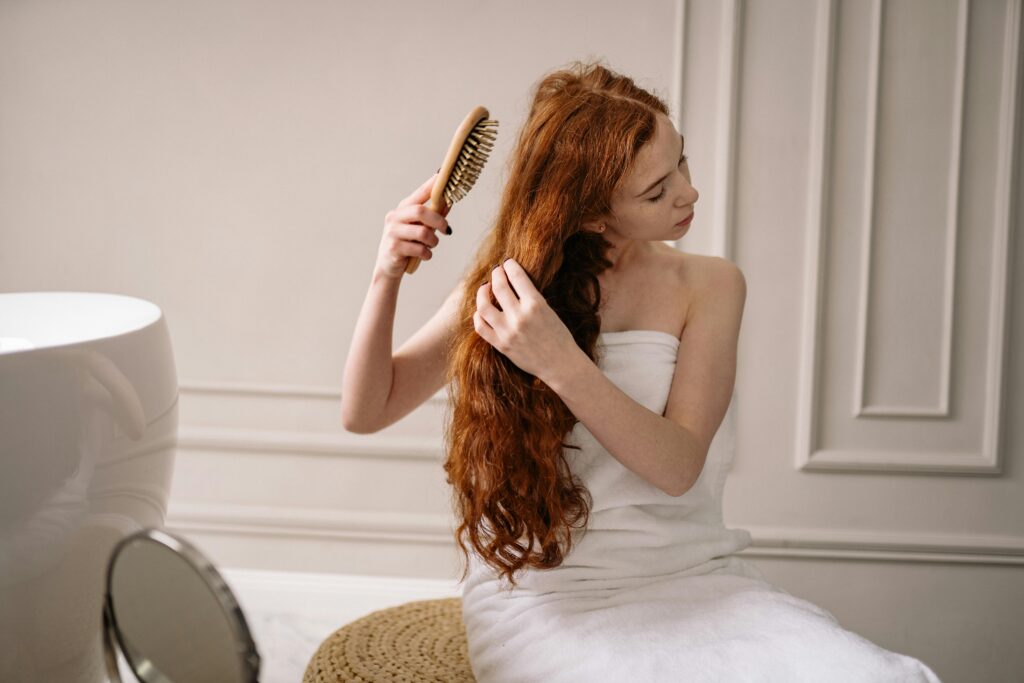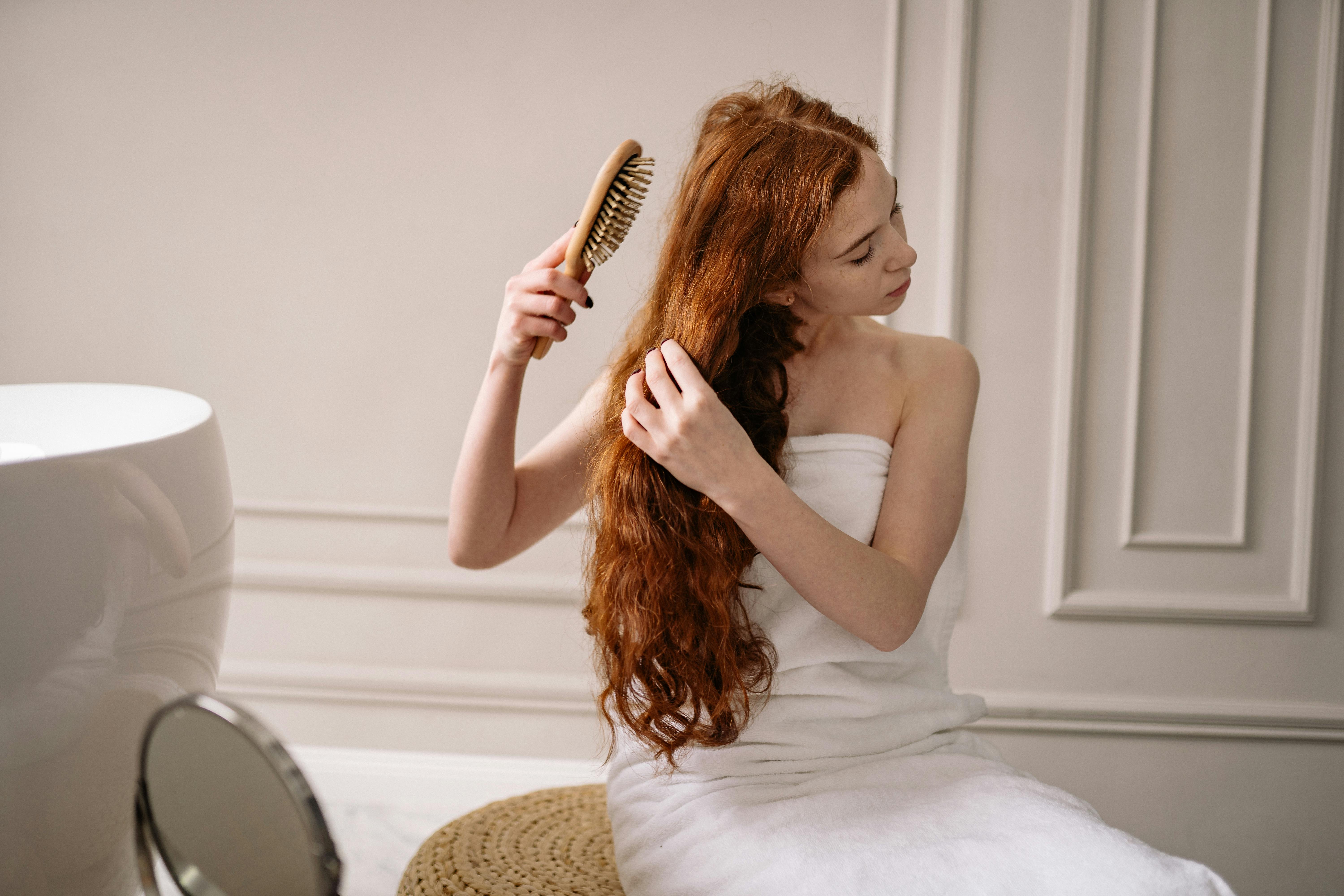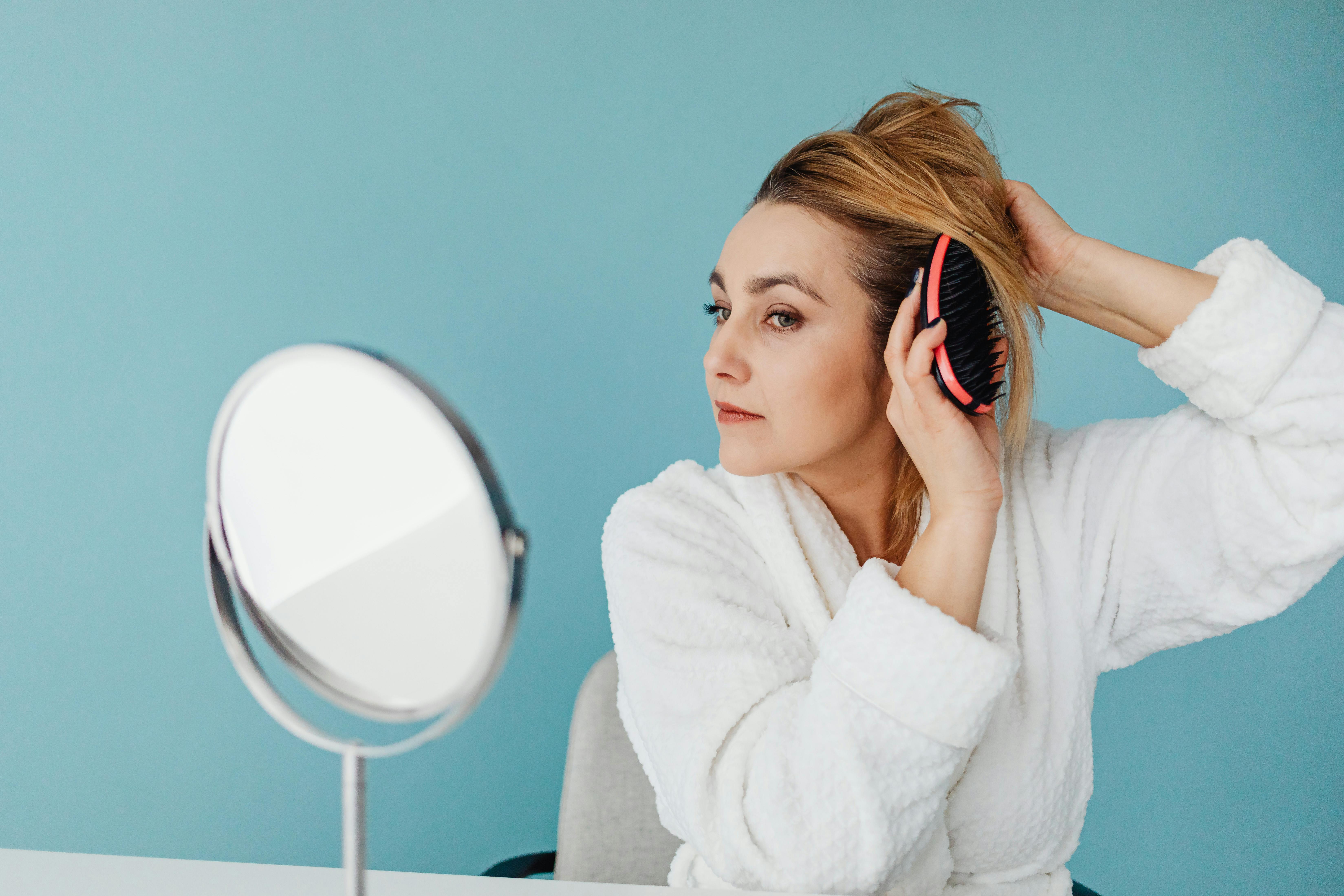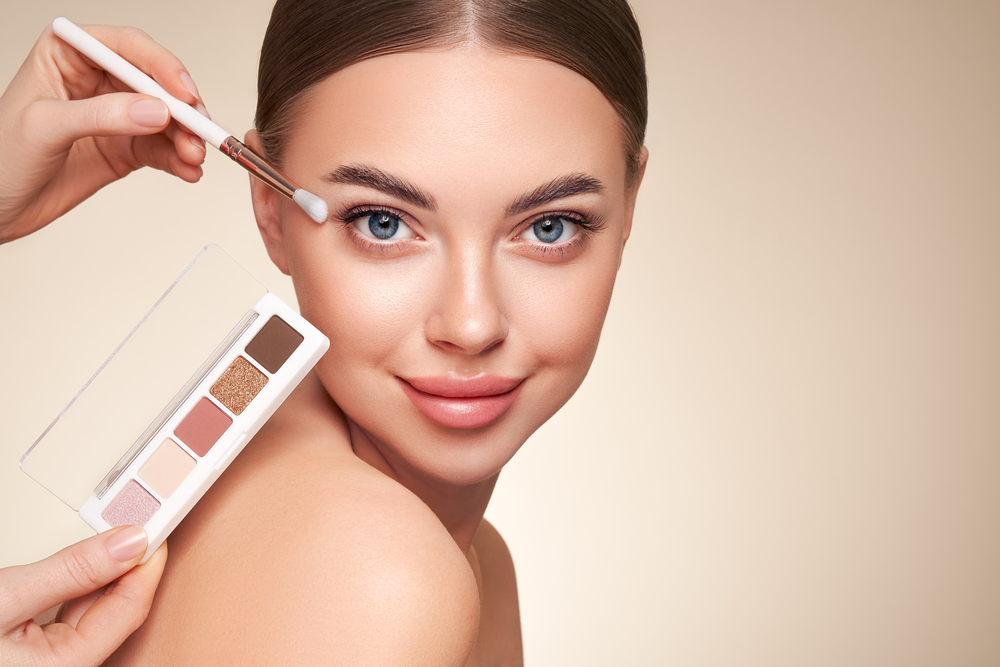
Have you ever found yourself in the hair care aisle, wondering “What Kind of Hair Brush Should I Use”?!? With so many options available, it can be overwhelming to select the right one. Each type of hair brush serves a specific purpose, whether it’s untangling stubborn knots or achieving a professional-looking blowout at home.
It’s essential to choose a hair brush that suits your specific hair type in order to maintain healthy locks. Using an unsuitable brush can result in breakage, frizz, and even scalp irritation. Regardless of whether your hair is fine and delicate or thick and unruly, there’s a perfect brush out there waiting to simplify your life.
In this article, you’ll discover:
- The various types of hair brushes and their specific benefits.
- How understanding your hair type can help you select the right tool.
- Tips on effectively using these brushes for healthier, happier hair.
Get ready to learn how to choose a hair brush that will take your hair care routine to the next level!
Understanding Hair Types
Hair isn’t just hair; it’s a whole personality of its own. Whether you’re rocking fine hair, thick hair, curly hair, or coarse hair, each type has its unique characteristics that play a big role in choosing the right brush.
Fine Hair
Fine hair can sometimes feel like the delicate flower of the hair world. It’s often more prone to breakage and can easily appear flat. Choosing a brush with soft bristles—like a boar bristle brush—can help reduce tension and prevent damage while distributing natural oils for added shine.
Challenges:
- Prone to tangles
- Can lack volume
- Easily damaged by harsh brushes
Thick Hair
Thick hair is like a lion’s mane—bold and beautiful but needing some taming. A nylon bristle brush can handle this beastly task by detangling without breaking strands and helping manage any unruly volume.
Challenges:
- Tangles easily
- Takes longer to dry
- Requires strong tools for detangling
Curly Hair
Curly hair is all about embracing those fabulous coils. However, it does have a bit of a rebellious streak. The key is using brushes that enhance curls without causing frizz, such as wide-tooth combs or specific detangling brushes designed for curls.
Challenges:
- Prone to frizz
- Needs careful detangling
- Requires moisture retention
Coarse Hair
Coarse hair is strong and resilient but can sometimes feel like it has a mind of its own. Brushes with sturdy bristles, such as those made from nylon, are great for managing this type of hair without causing breakage.
Challenges:
- Can be difficult to style
- May feel rough or dry
- Needs strong control during brushing
Understanding your hair type is like getting to know your best friend—it helps you make informed decisions on what will work best in your hair care routine. This knowledge allows you to select the ideal brush that complements your unique needs and challenges so you can flaunt those locks with confidence!

Types of Hair Brushes and Their Benefits
1. Detangling Brushes: The Ultimate Solution for Tangles
Anyone who’s ever dealt with a knotty hair situation knows the struggle is real. Enter the detangling brush, your new best friend in the battle against tough tangles and knots. These brushes are designed with flexibility and gentle bristles that glide through hair without tugging or pulling, making them an essential tool for any hair care routine.
Features and Benefits of Detangling Brushes:
- Flexible Bristles: The magic lies in the flexible bristles that bend with your hair, ensuring minimal breakage.
- Gentle on Hair: Whether used on wet or dry hair, these brushes reduce friction and tension, which means less damage and split ends.
- Versatility: Designed for all hair types, they work wonders on everything from fine strands to thick curls.
Detangling brushes come in various shapes and sizes, but their primary goal is always the same—smooth out those pesky tangles without making you wince.
Recommended Usage for Different Hair Types:
- Fine Hair: Opt for a detangler brush with softer bristles to prevent unnecessary stress on delicate strands.
- Thick or Curly Hair: A sturdy detangling brush can manage dense locks effectively, ensuring each strand gets the attention it deserves without causing a frizz frenzy.
- Wavy Hair: For those blessed with waves, these brushes help define curls while keeping them tangle-free.
When you’re asking yourself “What kind of hair brush should I use?”, consider how often you deal with tangles. If knots are your nemesis, a detangling brush might just be the superhero you’ve been waiting for. They’re not only about combating tangles; they’re about enhancing your entire hair care routine by making brushing a breeze.
Whether you’re tackling post-shower knots or pre-styling prep, a good detangler brush is a staple that you’ll wonder how you ever lived without. And remember, while your trusty detangler is handling the tangles, other specialty brushes like cushion brushes or thermal brushes have their own roles in keeping your locks looking luscious.
2. Specialty Brushes for Specific Hair Needs
When it comes to finding the perfect hair brush, understanding the nuances of different specialty brushes can make all the difference. Whether you’re battling frizz, aiming for shine, or managing thick locks, there’s a brush designed just for you.
Boar Bristle Brush: A Game Changer for Fine and Curly Hair Types
For those with fine or curly hair, the boar bristle brush is a true game changer. These brushes are adored for their ability to:
- Reduce Frizz: The natural bristles distribute your scalp’s oils through your hair, which naturally tames frizz and flyaways.
- Enhance Shine: By smoothing the cuticle layer, boar bristle brushes promote glossy, healthy-looking hair.
- Gentle Detangling: While they might not replace your favorite detangler brush for serious knots, they do offer a gentle way to manage day-to-day tangles without causing breakage.
Imagine starting your day with a brush that not only styles but also pampers your locks—sounds dreamy, right?
Nylon Bristle Brush: The Go-To Choice for Thick Hair
Thick-haired beauties often face challenges when it comes to detangling without damage. Enter the nylon bristle brush:
- Efficient Detangling: Nylon bristles are sturdy enough to work through thick strands without snapping them.
- Minimizing Breakage: The flexibility of nylon helps to gently separate hair without pulling or breaking it.
No more wrestling matches with your mane! Instead, let these sturdy bristles glide through effortlessly, making styling a breeze.
Selecting the right specialty brush can transform your daily hair routine from drab to fab. As we delve deeper into the world of hair brushes, you’ll discover even more tools tailored to meet specific needs and elevate your hair care game.
However, it’s important to note that using certain products like conditioners improperly can lead to adverse effects such as hair loss. Hence, while selecting specialty brushes is crucial, being informed about your overall hair care routine is equally essential.
3. Paddle Brushes and Vented Brushes: Styling Made Easy with These Must-Have Tools!
When it comes to achieving those sleek, Instagram-worthy hairstyles, paddle brushes and vented brushes are your trusty sidekicks. Let’s dive into why these tools should be part of your hair care arsenal.
Paddle Brush: Perfect Tool for Smooth and Straight Styles
The paddle brush is the go-to for anyone aiming for a smooth and polished look. Its wide, flat surface covers a lot of ground quickly, making it ideal for long, straight hair. The bristles are designed to help detangle without pulling or causing breakage, which is a blessing for those who battle with knots on the regular.
Tips for using a paddle brush effectively:
- Start brushing at the ends of your hair and work your way up to avoid tugging.
- Use it while blow-drying to flatten flyaways and enhance shine.
- Pair with a heat protectant spray to keep your locks healthy while styling.
With its ability to glide through hair smoothly, the paddle brush can transform frizzy chaos into silky elegance in no time!
Vented Brush: Quick Drying and Styling with Ease
If you’re always in a hurry (aren’t we all?), the vented brush is about to become your best friend. Designed with openings that allow hot air to pass through, this brush significantly cuts down drying time—perfect for those busy mornings.
Why choose a vented brush?
- Speeds up blow-drying: Thanks to its design, hot air circulates better, reducing the time spent under the dryer.
- Adds volume: The strategic bristle placement helps lift hair at the roots for added oomph.
- Reduces heat damage: Less time with heat tools means less potential for damage.
Whether you’re looking to master that effortless blow-out or just need a quick fix before dashing out the door, these brushes deliver style with speed!
4. Round Brushes: Creating Beautiful Curls and Waves with Precision!
Round Brush Sizes Explained
When it comes to round hairbrushes, size truly does matter! Different sizes can help you achieve the curl or wave of your dreams:
- Small (1 inch or less): Perfect for creating tight curls or adding volume at the roots for short hair. It’s like having a curling iron but without the heat damage!
- Medium (1 to 2 inches): Ideal for medium-length hair, this size works wonders for beachy waves and bouncy curls.
- Large (2 inches and above): Best for long locks, a large round brush is your go-to for smooth, loose waves and straight styles with a bit of body.
Mastering Blow-Drying Techniques with a Round Brush
Achieving salon-worthy curls and waves at home is possible with the right technique:
- Prep Your Hair: Start by using a detangler brush to remove any knots, then apply a heat protectant—because nobody wants fried ends!
- Section It Out: Use a rat tail comb to divide your hair into manageable sections. This ensures each part gets the attention it deserves.
- Roll and Dry: Take your round brush and wrap a section of hair around it. Begin blow-drying from the roots, slowly rolling the brush downward while applying tension for smoothness.
- Cool It Down: Once dry, blast your hair with cool air to set the style—this step is key for long-lasting curls.
- Release and Repeat: Gently unwind the brush from your hair to reveal beautiful curls or waves. Repeat for all sections.
Round brushes are just one piece of the puzzle in your hairstyling toolkit, alongside specialty brushes like thermal brushes or cushion brushes that offer their own unique benefits. Choosing between them depends on what kind of hair brush you’d like to use to achieve your desired look!
5. Cushion Brushes, Thermal Brushes, Teasing Brushes, Wide-Tooth Combs, Rat Tail Combs: Additional Tools to Complete Your Hair Care Arsenal!
Cushion Brushes: Pampering Your Scalp While Brushing
Ever wondered if a hair brush could give your scalp a little TLC? Enter the cushion brush! This lovely tool features a soft rubber base that gently massages your scalp with every stroke. Not only does it feel amazing, but it also helps stimulate blood circulation, which can promote healthier hair growth. Cushion brushes are perfect for those days when you want to unwind and treat yourself to a mini scalp massage while keeping your hair smooth and tangle-free.
Thermal Brushes: Turbocharging Your Blow-Drying Routine
If you’re someone who loves to style with heat, thermal brushes might just become your new best friend. These brushes have heat-conducting barrels (often made of ceramic or metal) that absorb the heat from your blow-dryer, making the drying process faster and more efficient. By distributing heat evenly, thermal brushes help minimize damage while giving you a sleek finish. They’re especially handy for creating volume or straightening your locks with precision. So next time you’re blow-drying for a night out or just want to speed up your morning routine, reach for a thermal brush for that salon-quality look.
Teasing Brushes, Wide-Tooth Combs, Rat Tail Combs: Versatile Tools for Every Hairstyle
- Teasing Brushes: Need a little oomph in your hairstyle? Teasing brushes are designed to add volume and texture. With densely packed bristles, they grip hair easily and allow you to backcomb sections without too much hassle. Perfect for those days when you want extra height in your ponytail or an updo that’s full of life.
- Wide-Tooth Combs: A must-have for anyone dealing with thick or curly hair! These combs glide through wet hair effortlessly without causing breakage. They’re also fantastic at distributing conditioner evenly during shower time—making detangling a breeze.
- Rat Tail Combs: Precision is key when it comes to styling, and rat tail combs deliver just that. The long pointy end is perfect for sectioning hair neatly or creating defined parts. It’s also great for backcombing small sections if you’re aiming for that perfectly teased volume.
When pondering the question “what kind of hair brush should I use?”, think about these specialty brushes and tools as part of your essential kit. Whether you’re looking to detangle, add volume, or style with finesse, having the right arsenal can make all the difference in achieving luscious locks effortlessly!
And speaking of specialty brushes, makeup brushes serve a similar purpose in the realm of beauty. From foundation to contouring, each type has its unique use that contributes to flawless application and stunning results.

Best Practices for Hair Brushing Techniques That Promote Healthy Locks
Brushing your hair might seem like a simple task, but getting it right can make a world of difference for your luscious locks. Let’s dive into some hair-savvy tips to keep your mane looking its best.
Recommended Brushing Frequency
- Fine or Thin Hair: Less is more! Aim to brush once a day to avoid breakage.
- Thick or Coarse Hair: Twice daily could be beneficial, especially if you’re prone to tangles.
- Curly or Textured Hair: Be gentle and brush only when necessary, often best when wet or damp to minimize frizz.
- Oily Hair: Frequent brushing helps distribute oils evenly, but be cautious not to overdo it.
Proper Techniques for Different Brushes
Detangling Brushes
Always start from the ends and work your way up. This minimizes pulling and breakage, especially on wet hair.
Pro Tip: For extra knotty days, spritz a leave-in conditioner before brushing.
Boar Bristle Brushes
Use long strokes from root to tip. This helps distribute natural oils and adds shine—perfect for fine or curly hair.
Smooth Operator: Ideal for giving your hair that polished look without static.
Nylon Bristle Brushes
Excellent for taming thick hair. Use with gentle pressure to glide through without snagging.
Static Be Gone: These brushes are great at reducing frizz and static electricity.
Paddle Brushes
Perfect for straightening hair. Brush in sections, starting from the crown downwards to achieve that sleek finish.
Speedy Styler: Quick and efficient for morning routines!
Round Brushes
Key tool for blow-drying. Roll under for volume or outwards for curls. Remember, size matters—larger barrels create loose waves, while smaller ones deliver tight curls.
Volume Mastery: Practice makes perfect; master the wrist twist for salon-like results!
Following these brushing techniques can transform your daily routine into a fabulous hair care ritual. Each stroke not only styles but nurtures your strands towards healthier growth and shine. So go ahead—let those brushes work their magic!
What Kind of Hair Brush Should I Use – Conclusion
Choosing the right hair brush is essential for maintaining healthy and beautiful hair. With so many options available, it’s important to know which type of brush is best suited for your specific hair type and styling needs.
Remember: The key to happy hair lies in finding a brush that caters to its requirements. Whether you need a detangling brush for easy knot removal or a boar bristle brush for added shine, each tool has its own benefits.
Here’s a quick guide to help you select the right hair brush:
- Fine or thinning hair? Opt for softer, natural bristles.
- Thick or coarse tresses? Nylon bristles are your best friend.
- Looking for sleek styles? Paddle brushes and vented options have got your back.
By using the appropriate hair brush, you’re not only managing your locks but also promoting healthier and more vibrant hair. Embrace your unique hair characteristics and let them lead you towards the perfect brush. Show your mane some love with tools specifically designed for you!
FAQs (Frequently Asked Questions)
What kind of hair brush should I use for my hair type?
Choosing the right hair brush depends on your specific hair type. For fine hair, a boar bristle brush can help reduce frizz and enhance shine. Thick hair benefits from a nylon bristle brush, which effectively detangles without causing breakage. Curly hair may require a detangling brush to manage tangles gently.
What are the benefits of using a detangling brush?
Detangling brushes are designed to gently glide through knots and tangles, minimizing breakage and damage. They are especially useful for all hair types, but particularly beneficial for curly or textured hair, as they help maintain the integrity of curls while preventing excessive pulling.
How do I choose the right brush for styling my hair?
Consider the style you want to achieve and your hair type. Paddle brushes are ideal for smooth, straight styles, while round brushes are great for creating curls and waves. Vented brushes are perfect for quick drying during blow-drying sessions due to their design that allows better airflow.
What is the difference between a cushion brush and a thermal brush?
Cushion brushes provide gentle stimulation to the scalp while brushing and are excellent for daily use. Thermal brushes, on the other hand, are designed to withstand heat from styling tools and help speed up drying time when blow-drying due to their heat-retaining properties.
How often should I brush my hair?
The recommended brushing frequency varies by hair type. Generally, it’s best to avoid over-brushing as it can lead to breakage. Fine hair may require less frequent brushing compared to thicker or curly hair types, which may benefit from more regular detangling sessions.
What techniques should I follow when using different types of brushes?
When using any brush, start from the ends of your hair and work your way up to minimize tangling. Use gentle strokes and avoid pulling too hard. For round brushes during blow-drying, wrap sections of hair around the barrel and pull gently while directing heat from your dryer for optimal results.

